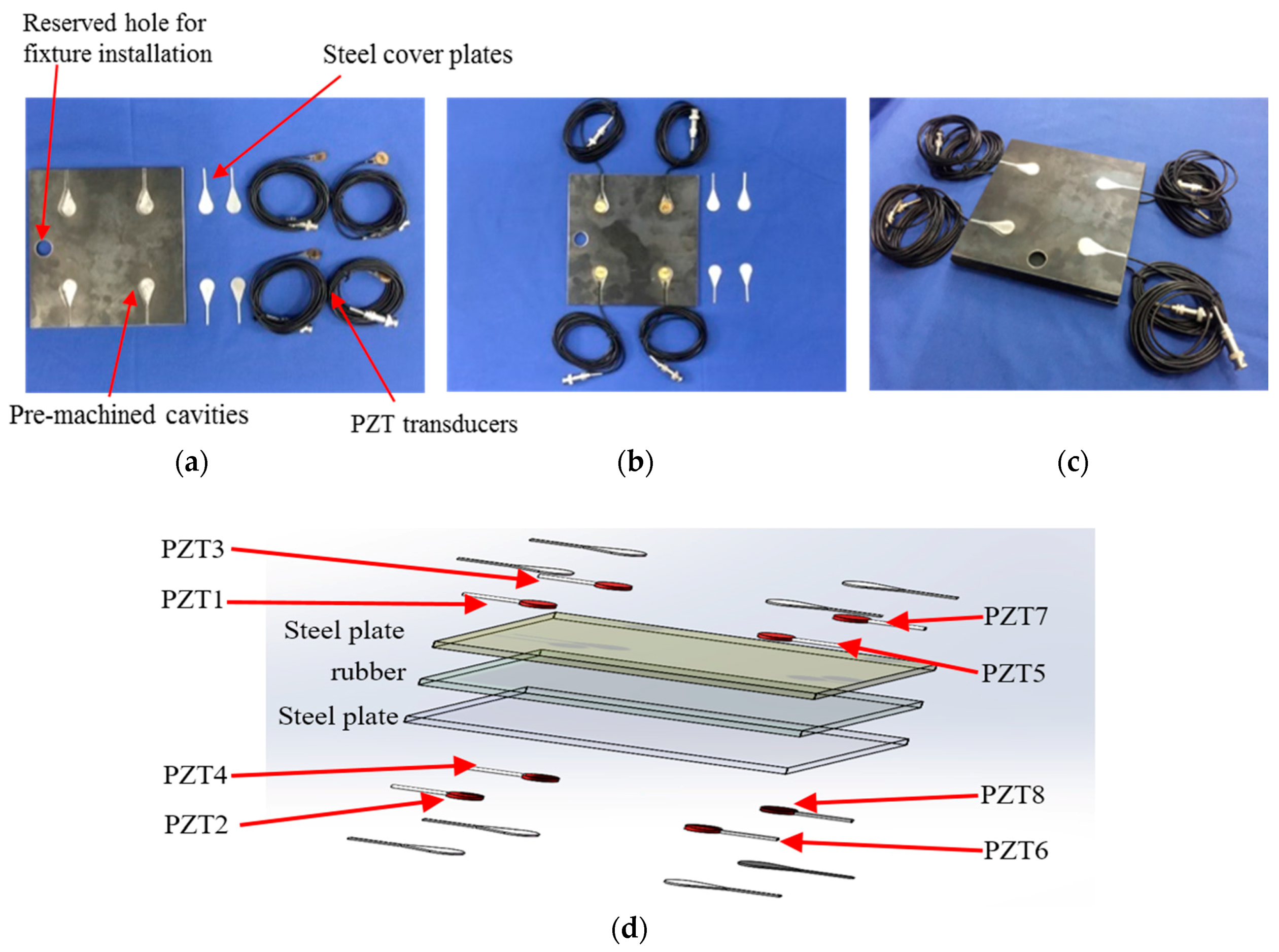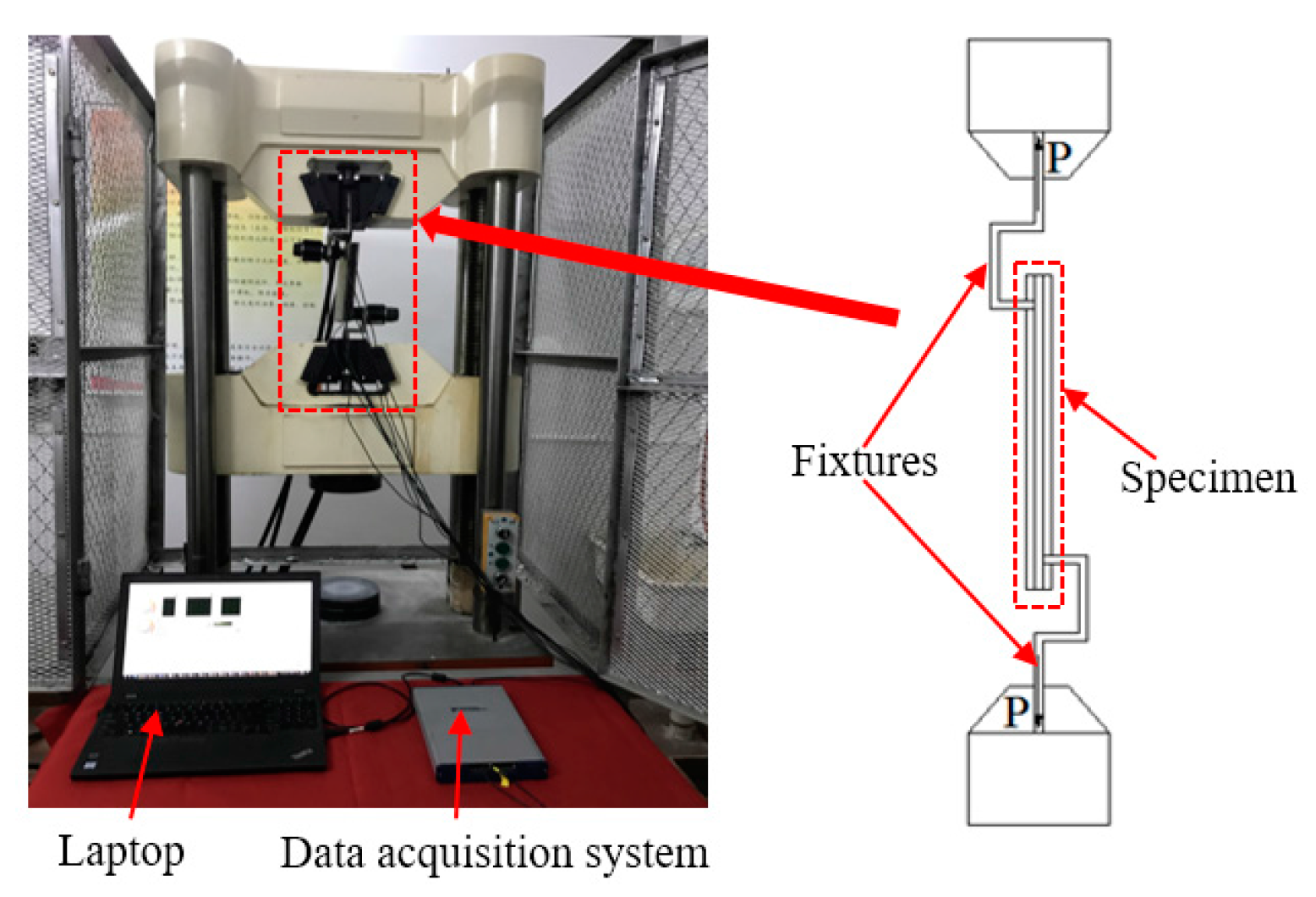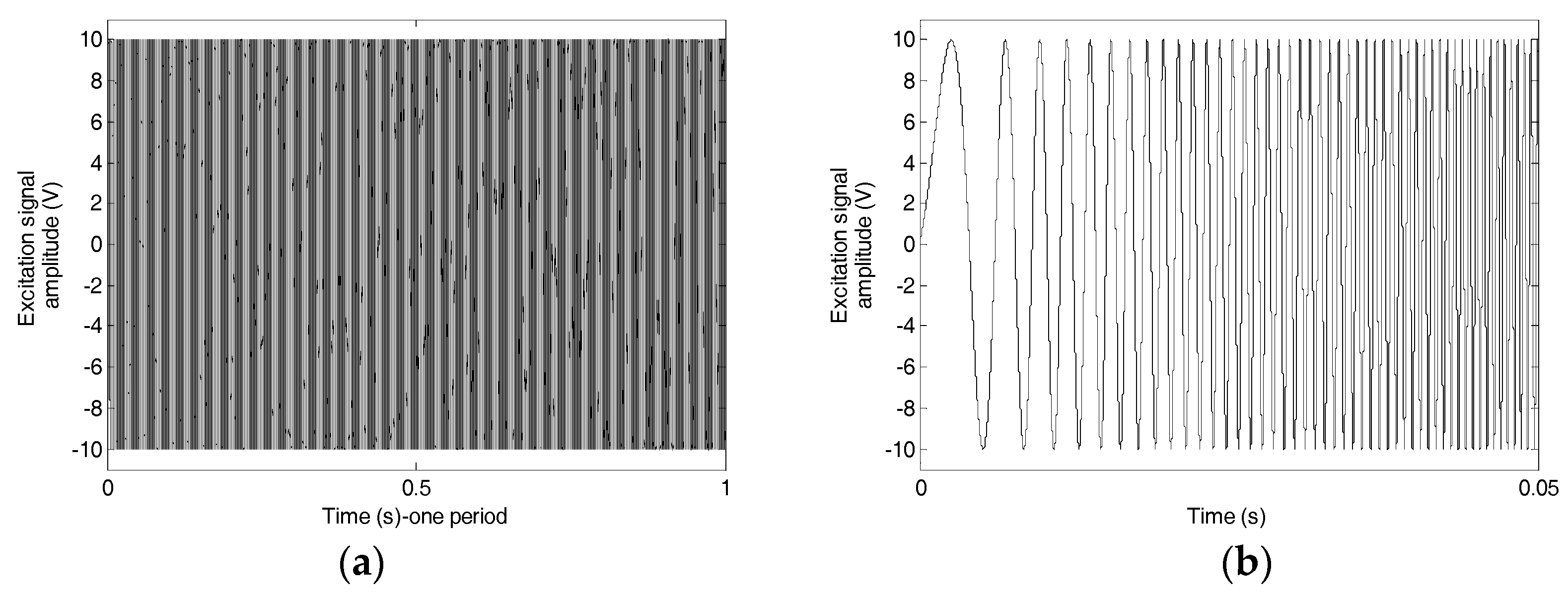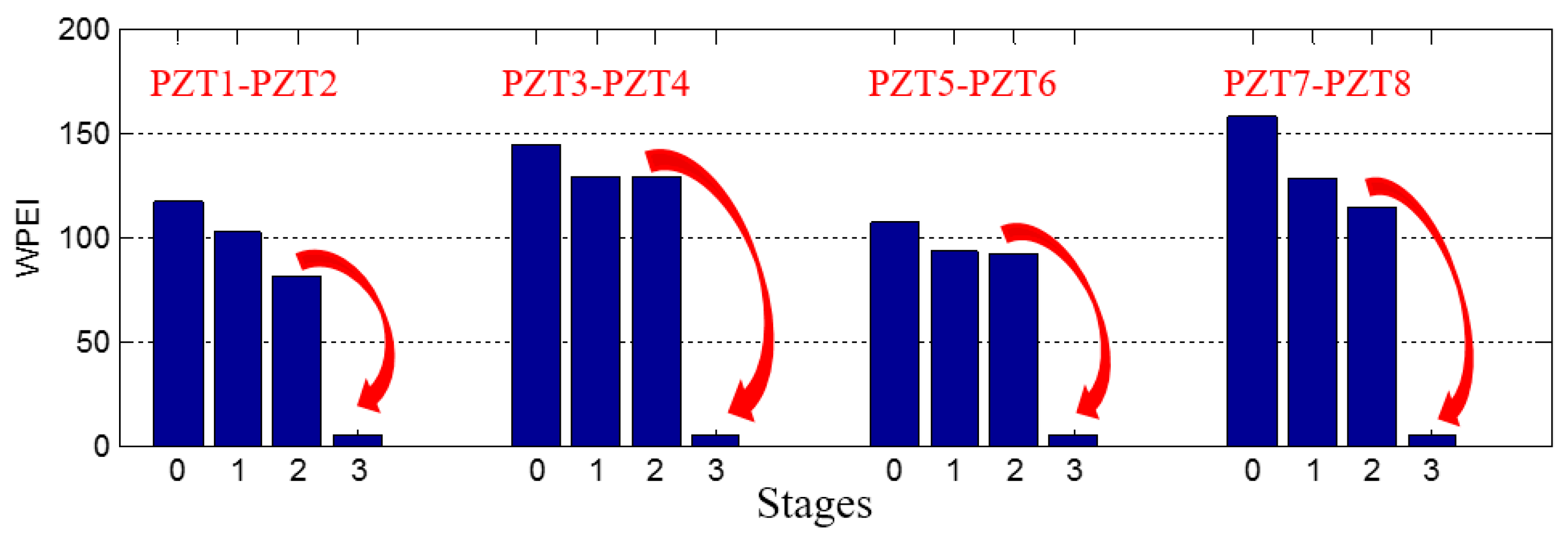Detection of Interfacial Debonding in a Rubber–Steel-Layered Structure Using Active Sensing Enabled by Embedded Piezoceramic Transducers
Abstract
:1. Introduction
2. Principles
2.1. Piezoceramic-Based Active Sensing Approach
2.2. Wavelet Packet-Based Energy Index (WPEI)
3. Experimental Setup and Procedure
3.1. Specimen with Installed PZT Transducers
3.2. Experimental Setup and Procedure
4. Experimental Results
4.1. Loading Results
4.2. Time Histories of the Received Signals
4.3. Wavelet Packet-Based Energy Index
5. Conclusions
Acknowledgments
Author Contributions
Conflicts of Interest
References
- Robinson, W.H. Lead-rubber hysteretic bearings suitable for protecting structures during earthquakes. Earthq. Eng. Struct. Dyn. 1982, 10, 593–604. [Google Scholar] [CrossRef]
- Warn, G.P.; Ryan, K.L. A review of seismic isolation for buildings: Historical development and research needs. Buildings 2012, 2, 300–325. [Google Scholar] [CrossRef]
- Dezfuli, F.H.; Alam, M.S. Shape memory alloy wire-based smart natural rubber bearing. Smart Mater. Struct. 2013, 22, 045013. [Google Scholar] [CrossRef]
- Kalpakidis, I.V.; Constantinou, M.C.; Whittaker, A.S. Modeling strength degradation in lead–rubber bearings under earthquake shaking. Earthq. Eng. Struct. Dyn. 2010, 39, 1533–1549. [Google Scholar] [CrossRef]
- Taylor, A.W.; Lin, A.N.; Martin, J.W. Performance of elastomers in isolation bearings: A literature review. Earthq. Spectra 1992, 8, 279–303. [Google Scholar] [CrossRef]
- Zhou, Z.; Han, G.; Tian, Q. Separation Test Method for Bridge Bearing Based on Displacement. J. Highw. Transp. Res. Dev. 2012, 4, 016. [Google Scholar]
- Burtscher, S.L.; Dorfmann, A. Compression and shear tests of anisotropic high damping rubber bearings. Eng. Struct. 2004, 26, 1979–1991. [Google Scholar] [CrossRef]
- Grouve, W.J.B.; Warnet, L.; Boer, A.D.; Akkerman, R.; Vlekken, J. Delamination detection with fibre bragg gratings based on dynamic behaviour. Compos. Sci. Technol. 2008, 68, 2418–2424. [Google Scholar] [CrossRef]
- Elvin, N.; Leung, C.K.Y.; Sudarshanam, V.S.; Ezekiel, S. A novel fiber optic delamination detection scheme: Theoretical and experimental feasibility studies. J. Intell. Mater. Syst. Struct. 1999, 10, 314–321. [Google Scholar] [CrossRef]
- Ibarra-Castanedo, C. Delamination detection and impact damage assessment of GLARE by active thermography. Int. J. Mater. Prod. Technol. 2012, 41, 5–16. [Google Scholar] [CrossRef]
- Shah, D.K.; Chan, W.S.; Joshi, S.P. Delamination detection and suppression in a composite laminate using piezoceramic layers. Smart Mater. Struct. 2015, 3, 293. [Google Scholar] [CrossRef]
- Okabe, Y.; Fujibayashi, K.; Shimazaki, M.; Soejima, H.; Ogisu, T. Delamination detection in composite laminates using dispersion change based on mode conversion of Lamb waves. Smart Mater. Struct. 2010, 19, 115013. [Google Scholar] [CrossRef]
- Kuhn, E.; Emmanuel, V.; Philippe, H. A comparison between thermionics and thermography for delamination detection in polymer matrix laminates. Compos. Struct. 2012, 94, 1155–1164. [Google Scholar] [CrossRef]
- Sohn, H.; Dutta, D.; Yang, J.Y.; Park, H.J.; DeSimio, M.; Olson, S.; Swenson, E. Delamination detection in composites through guided wave field image processing. Compos. Sci. Technol. 2011, 71, 1250–1256. [Google Scholar] [CrossRef]
- Wang, Y.; Zhu, X.; Hao, H.; Ou, J. Guided wave propagation and spectral element method for debonding damage assessment in RC structures. J. Sound Vib. 2009, 324, 751–772. [Google Scholar] [CrossRef]
- Wang, Y.; Hao, H. Modelling of guided wave propagation with spectral element: Application in structural engineering. Appl. Mech. Mater. 2014, 553, 687–692. [Google Scholar] [CrossRef]
- Dao, P.B.; Staszewski, W.J. Lamb wave based structural damage detection using cointegration and fractal signal processing. Mech. Syst. Signal Process. 2014, 49, 285–301. [Google Scholar] [CrossRef]
- Wandowski, T.; Malinowski, P.; Ostachowicz, W. Circular sensing networks for guided waves based structural health monitoring. Mech. Syst. Signal Process. 2016, 66–67, 248–267. [Google Scholar] [CrossRef]
- Żak, A.; Radzieński, M.; Krawczuk, M.; Ostachowicz, W. Damage detection strategies based on propagation of guided elastic waves. Smart Mater. Struct. 2012, 21, 035024. [Google Scholar]
- Soh, C.K.; Tseng, K.K.; Bhalla, S.; Gupta, A. Performance of smart piezoceramic patches in health monitoring of a RC bridge. Smart Mater. Struct. 2000, 9, 533. [Google Scholar] [CrossRef]
- Zhao, X.; Gao, H.; Zhang, G.; Ayhan, B.; Yan, F.; Kwan, C.; Rose, J.L. Active health monitoring of an aircraft wing with embedded piezoelectric sensor/actuator network: I. Defect detection, localization and growth monitoring. Smart Mater. Struct. 2007, 16, 1208. [Google Scholar] [CrossRef]
- Park, G.; Sohn, H.; Farrar, C.R.; Inman, D.J. Overview of piezoelectric impedance-based health monitoring and path forward. Shock Vib. Dig. 2003, 35, 451–463. [Google Scholar] [CrossRef]
- Venugopal, V.P.; Wang, G. Modeling and analysis of Lamb wave propagation in a beam under lead zirconate titanate actuation and sensing. J. Intell. Mater. Syst. Struct. 2015, 26, 1679–1698. [Google Scholar] [CrossRef]
- Giurgiutiu, V.; Zagrai, A.; Jing, B.J. Piezoelectric wafer embedded active sensors for aging aircraft structural health monitoring. Struct. Health Monit. 2002, 1, 41–61. [Google Scholar] [CrossRef]
- Wang, C.H.; Rose, J.T.; Chang, F.K. A synthetic time-reversal imaging method for structural health monitoring. Smart Mater. Struct. 2004, 13, 415. [Google Scholar] [CrossRef]
- Providakis, C.P.; Stefanaki, K.D.; Voutetaki, M.E.; Tsompanakis, J.; Stavroulaki, M.E. Damage detection in concrete structures using a simultaneously activated multi-mode PZT active sensing system: Numerical modelling. Struct. Infrastruct. Eng. 2014, 10, 1451–1468. [Google Scholar] [CrossRef]
- Kong, Q.; Robert, R.H.; Silva, P.; Mo, Y.L. Cyclic Crack Monitoring of a Reinforced Concrete Column under Simulated Pseudo-Dynamic Loading Using Piezoceramic-Based Smart Aggregates. Appl. Sci. 2016, 6, 341. [Google Scholar] [CrossRef]
- Feng, Q.; Kong, Q.; Huo, L.; Song, G. Crack detection and leakage monitoring on reinforced concrete pipe. Smart Mater. Struct. 2015, 24, 115020. [Google Scholar] [CrossRef]
- Chalioris, C.E.; Papadopoulos, N.A.; Angeli, G.M.; Karayannis, C.G.; Liolios, A.A.; Providakis, C.P. Damage Evaluation in Shear-Critical Reinforced Concrete Beam using Piezoelectric Transducers as Smart Aggregates. Open Eng. 2015, 5, 373–384. [Google Scholar] [CrossRef]
- Voutetaki, M.E.; Papadopoulos, N.A.; Angeli, G.M.; Providakis, C.P. Investigation of a new experimental method for damage assessment of RC beams failing in shear using piezoelectric transducers. Eng. Struct. 2016, 114, 226–240. [Google Scholar] [CrossRef]
- Chalioris, C.E.; Karayannis, C.G.; Angeli, G.M.; Papadopoulos, N.A.; Favvata, M.J.; Providakis, C.P. Applications of Smart Piezoelectric Materials in a Wireless Admittance Monitoring System (WiAMS) to Structures-Tests in RC Elements. Case Stud. Constr. Mater. 2016, 5, 1–18. [Google Scholar] [CrossRef]
- Xu, B.; Zhang, T.; Song, G.; Gu, H. Active interface debonding detection of a concrete-filled steel tube with piezoelectric technologies using wavelet packet analysis. Mech. Syst. Signal Process. 2013, 36, 7–17. [Google Scholar] [CrossRef]
- Zeng, L.; Parvasi, S.M.; Kong, Q.; Huo, L.; Li, M.; Song, G. Bond slip detection of concrete-encased composite structure using shear wave based active sensing approach. Smart Mater. Struct. 2015, 24, 125026. [Google Scholar] [CrossRef]
- Qin, F.; Kong, Q.; Li, M.; Mo, Y.L.; Song, G.; Fan, F. Bond slip detection of steel plate and concrete beams using smart aggregates. Smart Mater. Struct. 2015, 24, 115039. [Google Scholar] [CrossRef]
- Wu, F.; Chang, F.K. Debond detection using embedded piezoelectric elements for reinforced concrete structures-Part II: Analysis and algorithm. Struct. Health Monit. 2006, 5, 17–28. [Google Scholar] [CrossRef]
- Liang, Y.; Li, D.; Parvasi, S.M.; Kong, Q.; Song, G. Bond-slip detection of concrete-encased composite structure using electro-mechanical impedance technique. Smart Mater. Struct. 2016, 25, 095003. [Google Scholar] [CrossRef]
- Zhuang, Y.Q.; He, Y.G.; Xu, Q.C. Sandwich PZT/polymer composite transducer. Ferroelectrics 1983, 49, 241–249. [Google Scholar]
- Mamada, S.; Yaguchi, N.; Hansaka, M.; Yamato, M.; Yoshida, H. Performance improvement of piezoelectric-rubber by particle formation of linear aggregates. J. Appl. Polym. Sci. 2014, 131, 39862. [Google Scholar] [CrossRef]
- Mamada, S.; Yaguchi, N.; Hansaka, M.; Yamato, M.; Yoshida, H. Particle Alignment Condition and Size Influence on the d33 of the Pseudo-1–3 Piezoelectric Ceramic/Rubber Composite. e-J. Soft Mater. 2015, 11, 1–6. [Google Scholar] [CrossRef]
- Mamada, S.; Yaguchi, N.; Hansaka, M.; Yamato, M.; Yoshida, H. Fabrication of Piezoelectric-Rubber of Large Piezoelectric Property. MRS Online Proc. Libr. Arch. 2014, 1622, 17–23. [Google Scholar] [CrossRef]
- Zhang, Y.; Xu, F.; Zhang, T.; Wu, C. Application of electro-mechanical impedance sensing technique for online aging monitoring of rubber. Intell. Autom. Soft Comput. 2012, 18, 1101–1109. [Google Scholar] [CrossRef]
- Kong, Q.; Wang, R.; Song, G.; Yang, Z.J.; Still, B. Monitoring the soil freeze-thaw process using piezoceramic-based smart aggregate. J. Cold Reg. Eng. 2014, 28, 06014001. [Google Scholar] [CrossRef]
- Jiang, T.; Kong, Q.; Wang, W.; Huo, L.; Song, G. Monitoring of Grouting Compactness in a Post-Tensioning Tendon Duct Using Piezoceramic Transducers. Sensors 2016, 16. [Google Scholar] [CrossRef] [PubMed]
- Qian, F.; Yi, Z.; Nian, Z.; Hao, W. Design of remote real-time monitoring system based on GPRS for railway roadbed subsidence. J. Geod. Geodyn. 2013, 3, 035. [Google Scholar]
- Yan, S.; Ma, H.; Li, P.; Song, G.; Wu, J. Development and Application of a Structural Health Monitoring System Based on Wireless Smart Aggregates. Sensors 2017, 17. [Google Scholar] [CrossRef] [PubMed]










| Materials | Parameters | Values | Unit |
|---|---|---|---|
| Steel plate | Dimension | 20 × 20 × 0.6 | cm |
| Young’s modulus | 206 | GPa | |
| Density | 7.9 | g/cm3 | |
| Poisson’s ratio | 0.25 | - | |
| Rubber layer | Dimension | 20 × 20 × 0.5 | cm |
| Young’s modulus | 0.0078 | GPa | |
| Density | 1.27 | g/cm3 | |
| Poisson’s ratio | 0.47 | - | |
| PZT-transducer | Dimension | φ18 × 3 | mm |
| Piezoelectric strain coefficients | 2450 | pC/N |
© 2017 by the authors. Licensee MDPI, Basel, Switzerland. This article is an open access article distributed under the terms and conditions of the Creative Commons Attribution (CC BY) license (http://creativecommons.org/licenses/by/4.0/).
Share and Cite
Feng, Q.; Kong, Q.; Jiang, J.; Liang, Y.; Song, G. Detection of Interfacial Debonding in a Rubber–Steel-Layered Structure Using Active Sensing Enabled by Embedded Piezoceramic Transducers. Sensors 2017, 17, 2001. https://doi.org/10.3390/s17092001
Feng Q, Kong Q, Jiang J, Liang Y, Song G. Detection of Interfacial Debonding in a Rubber–Steel-Layered Structure Using Active Sensing Enabled by Embedded Piezoceramic Transducers. Sensors. 2017; 17(9):2001. https://doi.org/10.3390/s17092001
Chicago/Turabian StyleFeng, Qian, Qingzhao Kong, Jian Jiang, Yabin Liang, and Gangbing Song. 2017. "Detection of Interfacial Debonding in a Rubber–Steel-Layered Structure Using Active Sensing Enabled by Embedded Piezoceramic Transducers" Sensors 17, no. 9: 2001. https://doi.org/10.3390/s17092001






